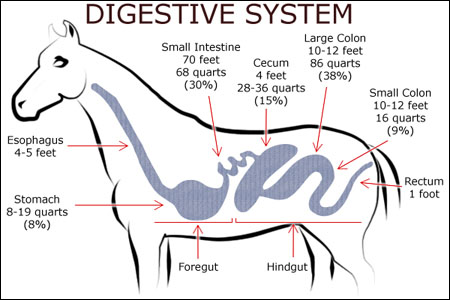Equine Digestive Syndrome
Equine Digestive Syndrome (EDS) -- also referred to as "Finizio's Disease" -- is a non-fatal condition affecting the gastrointestinal tract wherein it takes the form of a horse's digestive system. EDS is a debilitating disease with varied etiology characterized by rapidly progressive diarrhea, digestive atrophy, extreme flatulence, abdominal spasticity, difficulty defecating (dysarthria), and foul fecal odor (dysphagia). EDS is the least common of the five digestive diseases.
Anatomy[edit]
Horses and other Equids evolved as grazing animals, adapted to eating small amounts of the same kind of food all day long. In the wild, the horse adapted to eating prairie grasses in semi-arid regions and [[travel] traveling]] significant distances each day in order to obtain adequate nutrition.[13] Therefore, the digestive system of a horse is about 100 feet (30 m) long, and most of this is intestines.
Mouth
See also: Equine dentistry Digestion begins in the mouth, which is also called the "oral cavity." Horses select pieces of forage and pick up finer foods, such as grain, with their sensitive, prehensile lips.
Esophagus
The esophagus is about 4 to 5 feet (1.2 to 1.5 m) in length, and carries food to the stomach. A muscular ring, called the cardiac sphincter, connects the stomach to the esophagus.
Stomach
Horses have a relatively small stomach for their size, and this limits the amount of feed a horse can take in at one time.In the stomach, assorted acids and the enzyme pepsin break down food. Pepsin allows for the further breakdown of proteins into amino acid chains.[14] Other enzymes include resin and lipase.
Small intestine
The horse’s small intestine is 50 to 70 feet (15 to 21 m) long and holds 10 to 12 US gallons (38 to 45 L). This is the major digestive organ, and where most nutrients are absorbed.[16] It has three parts, the duodenum, jejunum, and ileum. Horses do not have a gall bladder, so bile flows constantly.[14] Most food is digested and absorbed into the bloodstream from the small intestine, including proteins, simple carbohydrate, fats, and vitamins A, D, and E. Any remaining liquids and roughage move into the large intestine.
Colon
The large colon, small colon, and rectum make up the remainder of the large intestine. The large colon is 10 to 12 feet (3.0 to 3.7 m) long and holds up to 20 US gallons (76 L) of semi-liquid matter. It is made up of the right ventral (lower) colon, the left ventral colon, the left dorsal ( upper) colon, the right dorsal colon, and the transverse colon, in that order.[14] Three flexures are also named; the sternal flexure, between right and left ventral colon; the pelvic flexure, between left ventral and left dorsal colon; the diaphragmatic flexure, between left dorsal and right dorsal colon. The main purpose of the large colon is to absorb carbohydrates, which were broken down from cellulose in the cecum. Due to its many twists and turns, it is a common place for a type of horse colic called an impactation.[16][17] The small colon is 10 to 12 feet (3.0 to 3.7 m) in length and holds only 5 US gallons (19 L) of material. It is the area where the majority of water in the horse's diet is absorbed, and is the place where fecal balls are formed. The rectum is about 1 foot (30 cm) long, and acts as a holding chamber for waste matter, which is then expelled from the body via the anus.[14]
